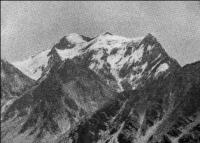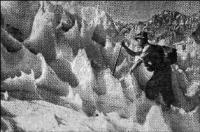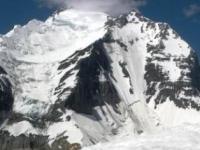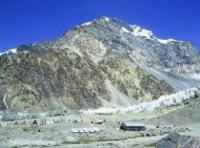Вы здесь
History of peak Korzhenevskaya.




Tops of Pamirs.
“Involuntary amazement encompasses you when a huge valley suddenly opens before you behind the ridge of the last spurs, and behind it stands the powerful Zaalai ridge, especially magnificent, when there are no clouds on it, and this whole panorama is flooded with dazzling sunce"
N. Korzhenevsky.
Climbing mountain peaks of Pamirs.
Peak Korzhenevskaya height of 7105 meters above sea level - the peak in the northern part of the ridge of the Academy of Sciences 13 kilometers from the peak of Ismail Somoni (former peak of Communism). It is one of the four seven-thousanders of the former USSR.
The peak was first discovered on August 23, 1910 by the Russian geographer N. L. Korzhenevsky and named after the wife of the discoverer Eugene Korzhenevskaya. The first attempt to climb was made in 1936 by climbers A. Dzhaparidze and N. Gusak.
The first ascent was carried out on August 22, 1953 by a group led by A. Ugarov along the northern ridge from the Korzhenevskaya glacier. The peak of Evgenia Korzhenevskaya is the fourth "seven-thousandth" of our country, the peak was discovered by N.L. Korzhenevsky August 10 (23), 1910 and named him the peak of "Eugenia." E.A. Beletsky gives the local name of the peak of Kuh-i-Santalak.
We did not have to hear this name. Apparently, it was used by locals for a very long time and rarely, and now it is completely forgotten, since the population from the upper Muk-Gu moved to the valleys and no one knows where the peak was called Kuh-i-Santalak.
The name Korzhenevskaya peak since 1927 was included on the geographical maps of our country and the whole world. It is rare that one of the people is honored to see his name in the name of the seven thousandth giant. Under what circumstances and by whose name is the fourth highest peak of our country named?
To do this, recall some of the milestones from the history of Central Asian exploration. It is known that back in the second half of the last century, scientists considered the territory of the then Turkestan less known than the surface of the moon, which even then could be seen through a telescope.
P.P. Semenov-Tyan-Shansky, I.V. Mushketov, A.P. Fedchenko, N.A. Severtsov, V.F. Oshanin and other major Russian geographers and travelers did a lot to study the territory of Central Asia. They aroused interest among the advanced youth of that time to the Pamirs, Tien-Shan, to the peoples inhabiting Turkestan, to its ancient and original culture.
It is no accident that Lieutenant Nikolai Korzhenevsky, who graduated from the first grade in 1901 at the Kiev Military School and had the right to choose any place of service, up to the regiments of the capital, preferred the modest Osh, lost among the distant southern outskirts of the Russian Empire.
“I want to be closer to the Pamirs,” the young man just promoted to officers told the general. Arriving in Osh in the fall of 1901, only a year later Korzhenevsky got the opportunity to see the Pamir. Since then, he has not parted with the Pamirs and Central Asia for 57 years.
Only the years of study at the Military Commandant's Academy and the First World War temporarily separated Korzhenevsky from Central Asia. Ten years - from 1918 to 1928 - Korzhenevsky was in the ranks of the Red Army. At one time, he served as the head of the Turkfront supply with Mikhail Vasilyevich Frunze.
In 1920, not quitting the ranks of the Red Army, Korzhenevsky became a teacher of the Central Asian State University, which was then created by decree of Vladimir Ilyich Lenin. Since 1922, he was elected professor in the department of physical geography, which he was in charge of until the day of his death (autumn 1958).
A world-famous scientist Peru owns more than one hundred and fifty scientific works. He was an elder of Soviet glaciologists - specialists studying the life of the glacier. More than sixty years ago, the first page of the voluminous manuscript book “Journey to the Pamirs, to Wahan and Shugnan in 1903” was written with the firm hand of a future explorer and nature expert in Central Asia. For more than ten years this book served, in plain cloth binding, as a field diary of a researcher.
Together with him, the diary was at the Fedchenko Glacier, in the Alai Valley, traveling down the high-water river. Muksu, from Lake Zorkul along the Panj, stormed the snow passes of the Alai Range. A few years after the death of N.L. Korzhenevskogo E.S. Korzhenevskaya (his wife) gave me, as a gift, this voluminous manuscript book.
On the page of the Pamirian diary of Korzhenevsky dated August 10 (22), 1910, it is said that on that day, making his next trip to the Pamirs, the researcher stepped down from Altynmazar down the Muksu with many water.
For more than three hours, horsemen rode in a large trot along a wide valley occupied by a spilled river. More often along the banks there were dense tugai forests. Unfrightened hares, pheasants, foxes jumped out from under the hooves of horses.
On the rocks, like stone sculptures, the horned tauteks, mountain goats froze. It was a land of frightened animals. But Korzhenevsky was interested in another. Peaks, ranges, glaciers attracted his attention. Leaving the horses in the Ayujilga tract, N.L. Korzhenevsky, along with the guide, went further to better examine the glaciers flowing from the opposite northern slope of the Peter the Great ridge, as the researcher then believed.
Having walked a mile and a half on a steep slope covered with huge stones, and climbing a conglomerate ridge, Korzhenevsky saw the tongue of a large glacier and a series of snowy peaks above it directly in front of him.
“In the background of the glacier,” we read the page of records by Korzhenevsky, “were powerful snowy mountains, and among them there was a particularly huge, domed peak, which I would like to call the peak of Eugenia, in honor of my friend, who owes so much on his trips.
The height of this peak is hardly less than 25 thousand feet, in any case, it is not less than three handsome Altinmazar...". Altynmazar now, as then, at the beginning of our century served as a stronghold for work in the North-Western Pamirs.
Three handsome Altinmazar, mentioned by Korzhenevsky in a record dated August 10 (23), 1910, are known among climbers at the top of the Mazar Alps: Muzdzhilga, Sandal and Shilbe. Korzhenevsky somewhat exaggerated their height.
They reach about 6300 m above sea level (20 thousand feet). Until the mid-thirties, on the maps of the Pamirs, the peak discovered in 1910 by N.L. Korzhenevsky at the head of the Mushketov glacier, wrote the name "peak of Eugenia."
The popularity of Korzhenevsky as a researcher of the Pamir, an unrivaled authority in the geography of Central Asia, grew from year to year. By that time, three large glaciers were named after him - two of them in the Tien Shan and one in the Pamirs.
It was then that on the cards next to the name "Eugenia" the name Korzhenevskaya began to appear. Since then, the peak in Soviet and world geographic literature, on maps, in atlases, has become known as the peak of Evgenia Korzhenevskaya, the closest assistant, wife and companion of the researcher.
With his future wife, Evgenia Topornina, Korzhenevsky met soon after arriving in Osh. She was the daughter of his commander, the chief of the Osh garrison. After returning to Osh after graduation, she married a young officer, who, because of his extreme distraction, his passion for all kinds of scientific and technical innovations, was then called the “professor” in the garrison.
The Korzhenevskys lived in Osh for several more years. Evgenia Sergeyevna devoted her whole life to public education. She worked in educational institutions of Osh, Ferghana, Tashkent. Even at an advanced age, Evgenia Sergeyevna helped schoolchildren learn French and German, was interested in everything related to the Pamir.
She traveled a lot. Together with her husband, she was on alpine glaciers, in Genoa, Rome, Naples, and climbed Mount Vesuvius. Before the February Revolution, Korzhenevskaya, as a teacher of German in Ferghana, wrote a poem pamphlet on the king. He fell into the hands of the gendarmes.
Only the overthrow of the autocracy freed the young teacher from serious trouble. The old residents of Ferghana still remember the evening lectures of Korzhenevsky on the city square in 1918, which he arranged with Evgenia Sergeevna, showing the moon and stars through a telescope.
Evgenia Sergeevna Korzhenevskaya died in Tashkent on February 5, 1969, at 88 years of age. Traverses to the peak of Korzhenevskaya. The first ascent to the summit took place on August 22, 1953. The summits then reached the group of A. Ugarov.
For 22 years, through 1974 inclusive, 546 climbers visited the peak of Korzhenevskaya. In terms of attendance, the peak is in third place, after the peak of Lenin and the peak of Communism. Ten years after the first ascent, but now already from the Mushketov Glacier, two failed attempts were made to reach the summit on a new path by Leningraders (leader S. Savvon) and Tomsk citizens (leader B. Soustin). Only in 1968, the Donetsk climbers (leader B. Sivtsov), participating in the championship of the USSR, completed the planned route.
A significant role in the successful ascent of the Uzbeks, who repeated the path of the B. Sivtsov group, belongs to the commander of the MI-4 G.A. Sheverdyaev (Uzbek Directorate of the Civil Air Fleet). He landed a helicopter at an altitude of 4,000 meters above sea level, directly under the eastern slopes of the Korzhenevskaya peak, at the tip of the north-eastern ridge.
With this, the expedition was spared from difficult and lengthy approaches along the glacier and the Muksu valley, and could directly prepare for the ascent. Korzhenevskaya peak (7105 m) should not be confused with Korzhenevsky peak (6005 m) in the Zaalai ridge at the head of the Dzhanaydartak River, the first ascent of which was made by a group of climbers of the TurkVO in 1951.
Authority:
Books "Fan Mountains". Authors A.S. Mukhin, V.F. Gusev: "Nature of Tajikistan" Publishing House "Thought", 1982: Pavel Luknitsky. Travels in the Pamirs “Young Guard”, 1955: “Pamir”, publishing house “Planet” 1987, edited by corresponding member of the USSR Academy of Sciences M.S. Asimova.







